Review: Microsoft Lumia 950 and 950 XL (part 2 - Imaging)
Following on from my review of the Microsoft Lumia 950 XL and Lumia 950 in each of the review parts so far ('1' for each), and from my camera head to head with the older Lumia 930 and 1020, here's the second review part, common to both devices of course, since the camera units are identical, with just some back end processing differences that I note below. Summary? With just a few caveats, these are the best imaging smartphones to come out of the Nokia/Microsoft stable yet.
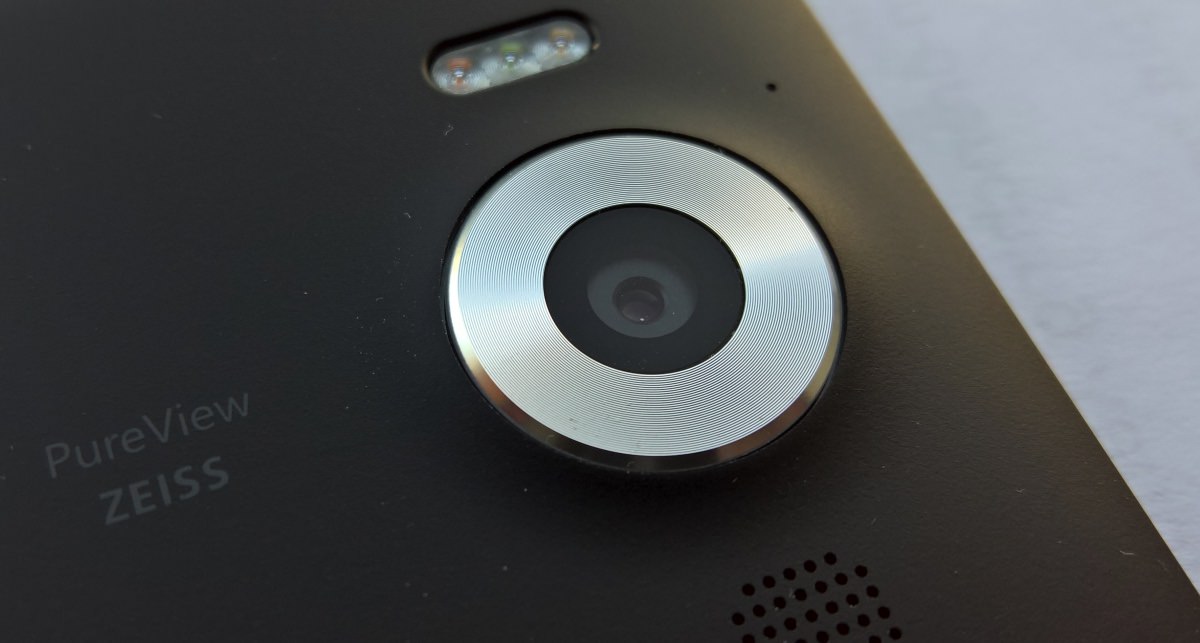
It's worth unpacking the raw specifications of the camera in the Lumia 950 and 950 XL:
- 20MP, PureView with oversampling - as it happens, the default capture mode is 16:9 aspect ratio, at 16MP, which is 'competitive' with Android flagship camera resolutions, though no one in their right mind needs that sort of resolution, of course. Which is why Sony uses 8MP oversampled results for its 'Superior auto' mode (on Android, in the Z range) and it's why Microsoft has preserved an oversampled mode for the Lumia 950, in this case 8MP and not 5MP as was the case for previous 'PureView' oversampling. This is sensible, as 5MP was feeling a little low. After all, we're now seeing 4K monitors and TVs and this corresponds exactly to 8MP, so it's the perfect choice.
In practice, this means that data for each pixel is calculated based on the value of light intensity falling on it directly and on that falling on the eight pixels directly around it. The exact algorithm and weighting used by Microsoft isn't known, plus there's all the Bayer filtering to do as well, but the ex-Nokia engineers have had a lot of practice at this and the results are uniformly excellent. With a caveat or two about sharpening, of which more below.
Using the Lumia 950 and 950 XL in this 8MP mode also means that you get lossless digital zoom, down to 1:1 on the sensor, working out to about 1.5x, which doesn't sound like much, but it's better than nothing and all you've lost is the oversampling.
- 1/2.4" sensor - Slightly larger than that in the much older Lumia 930 and 1520, this also represents a much newer and more sensitive sensor, i.e. 2015 spec, as used in many top of the line Android devices.
- f/1.9 aperture - Letting in almost half as much light again as the previous f/2.4 optics on the Lumia 930, from my experiences so far, I'd estimate that the combined effect of the larger, newer sensor and the larger aperture take the amount of light successfully gathered and processed up near that in the Lumia 1020 from 2013, the previous camera phone champion. See my detailed photo cature comparison feature. True, the underlying resolution is lower here and so oversampling and zoom aren't quite as effective, but on the other hand the camera island is around 3mm thinner than on the 1020, plus the lower number of megapixels being processed, allied to a far faster chipset, means vastly increased imaging performance overall - faster shots, faster shot-to-shot times, faster focussing, faster after-capture blending and rendering (compared to on the 930), and so on. More on this below.
- Fifth generation OIS - It's not entirely clear what has changed between each 'generation' of OIS in the Lumia range - that in the 920 was MEMS-based and clearly the first gen, that in the 1020 was more heavy-duty and used miniature ball bearings! The Lumia 830 claimed 'third generation OIS', back to MEMS again but with a 'flatter, thinner' design, and I've no idea what happened to the 'fourth' gen - maybe the 'unluckiness' of '4' meant that this was dropped!? In any case, the OIS here works brilliantly and the camera module is no larger than any non-OIS unit of similar spec, so it's an impressive engineering achievement. In practice, exposures as long as 1/5s are commonplace, and you can go much longer, even handheld, if you're steady enough. Or up to 4s if you give in and use a tripod. But that's cheating!
- Triple LED RGB flash - the idea here is that the Red, Blue and Green components of the to-the-eye white flash can be managed in software. I'm sure that is what happens and flash photos are admirably accurate in terms of colours as a result, though from my observations it's a combination of tuning the flash and then post-processng the captured photo, since - even with Rich Capture turned off - there's a pause of between one and three seconds after snapping a shot with flash, tapping on the thumbnail preview and then waiting for 'Adding the finishing touches' to go away. While the processing is happening, there's a slightly miscoloured image dimmed on screen, and then the final render appears, beautifully white balanced as if it was daylight. So the end product is impressive but it's not terribly clear how it's achieved. I'll obviously dig more into this in the next month as I use the Lumia 950 and 950 XL more in real life.
- 4K capture - I've mentioned this several times in our Lumia 950 coverage already, pointing out how easy it is to 'save photos from video and get creative', as the software puts it. Essentially picking as many 8MP frames as you like, saving them as JPGs. This works really well, and isn't too slow. A 30s 4K clip takes about 20 seconds to load (the first time, at least, on both devices, there doesn't seem much speed difference a lot of the time) and then saving/rendering a JPG takes about eight seconds. Definitely something to do at your leisure after an event, but not so slow that it's prohibitive. (And note that compiling a 8MP JPG from a 4K MP4 video stream is very non-trivial and the same operation on other platforms and devices takes a similar amount of time, if it's possible at all.)

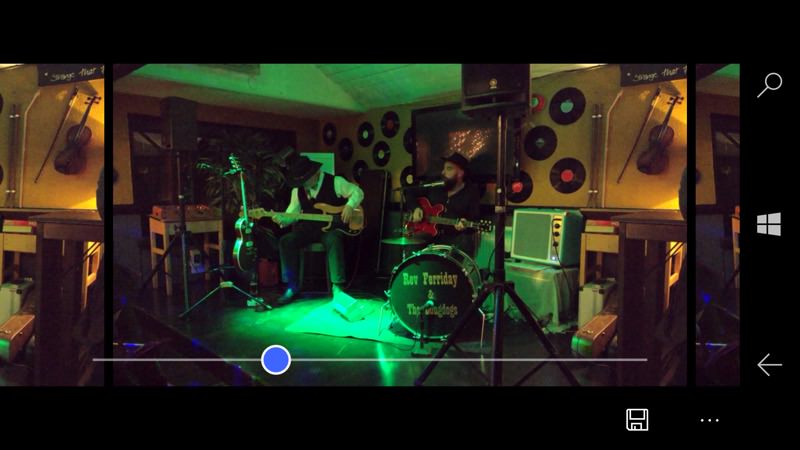
- Dedicated capture key - we've had this for years on Nokia smartphones before, but this is a first for a Microsoft-branded device, and it's most welcome. The obvious function - to focus (half press) and then take a photo (full depression) isn't actually it's most useful function. Far more important is being able to mash down on the key to start Camera quickly, sight-unseen, even from the locked state. This makes for a very speedy 'capture the moment' experience - and you can also assign a continued long press of this key to start shooting photos (at three or so a second) or video at your chosen resolution. In short, it's useful and customisable.
I should note that the capture key functions didn't always work perfectly - about one time in five long pressing the button didn't wake the camera - this has been a longstanding bug in Windows Phone and Windows 10 Mobile and seems to be accelerometer/gryoscope-related, in that the operation fails when the phone's in certain physical orientations. Very odd, and I do hope Microsoft tracks this down one day!
Plus the usual Lumia/Windows Camera manual adjustments, using the much-copied slide-out adjusters:

But on with some photo examples, with commentary. In each case, click through to open the image in a new window or to download it (according to your browser and preference). See what you think!
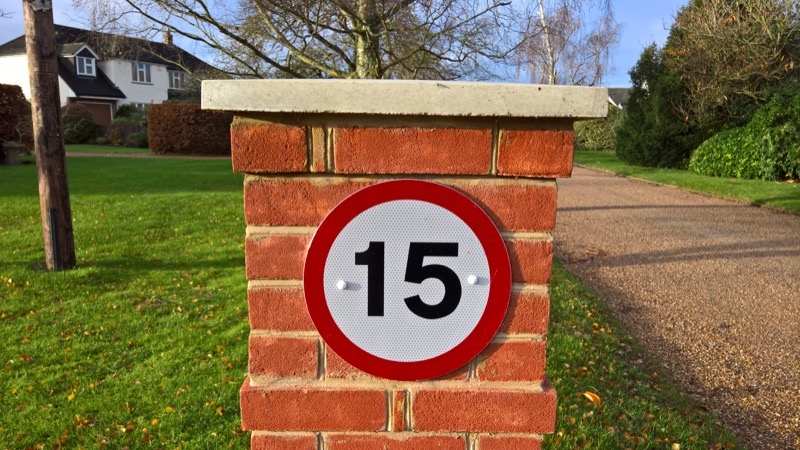
It's bright, it's sunny, it's a shot any camera phone can nail - and the Lumia 950 does a bang up job, here at 16MP...

A 16MP macro of some delicate leaves, out in winter, and a shocking colour - this is accurate though - you should see my garden!

Another macro into tricky lighting (into the sun, see the rays/flare), this time 8MP oversampled, look at the focus and detail on the leaf stem etc.
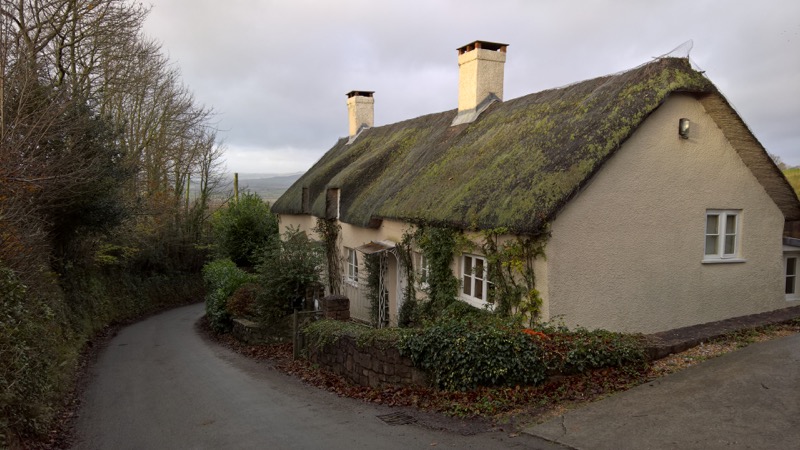
Under overcast skies and somewhat murky light, this oversampled 8MP shot of a Somerset cottage came up beautifully.

Indoors, at an event, an oversampled 8MP macro of a beautiful model scene... I was focussed on a spot in the centre of the frame, but other bokeh effects might have been interesting, of course.

Away from the sun, in the shade, some delicate blossom, extreme macro, only around 3 inches away. Shot at 16MP.
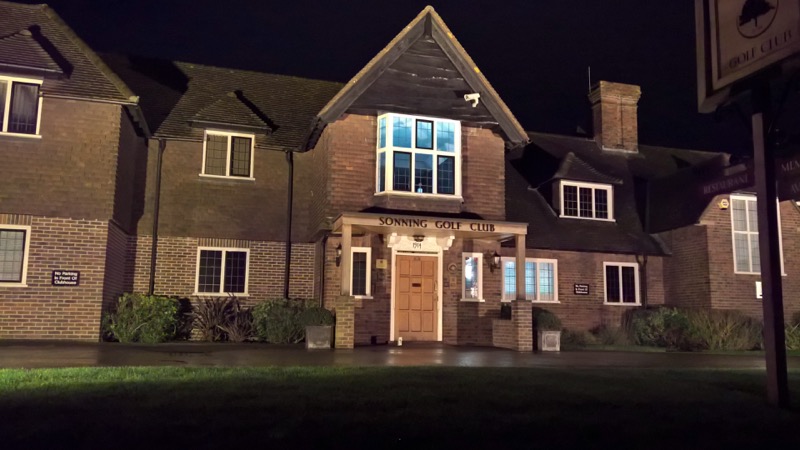
A floodlit building at night, shot at 8MP with oversampling. Focussing wasn't trivial, and the 950 needed several 'goes' at it. Pro tip: find the brightest spot in the viewfinder and tap on that!

Shot at 16MP, this flash shot of our pet froze the animal's motion very well....

Another triple LED flash test - the Lumia 950/XL does surprisingly well in these circumstances. I don't believe the EXIF data, I think that's made up from blended/bracketed Dynamic Flash shots - the photo used looks like it was captured quickly, though this was the best of half a dozen test shots like this (taken since), so maybe the 950 got a little lucky here in terms of catching me mid-movement. All the shots were 'OK', but don't expect true Xenon (proper) flash freezing of motion. I'll come back to this in a flash comparison with the Lumia 1020 in the future.

A top notch night time shot. Just perfect exposure and amazing detail - crop in on the centre of the 16MP frame and you'll see.

After using Rich Capture successfully, you'll see this function/button on-screen...

Sliding the control up and down adjusts the blend between the different exposures/flash as needed...
Adding the finishing touches
Either a stroke of genius or the bane of the Lumia 950/XL's life, every photo taken on the device, even if Rich Capture is disabled, is subject to some post-processing. There are some clever algorithms at work and the end result is almost always worth it, but it does seem as if the main Snapdragon processor is used for all this rather than the powerful GPU that's also on board. (If so, this could be fixed in a software update, of course.) The upshot of the processing in terms of the user experience is:
- taking shots, without stopping to preview - you'll be fine, there's no impact at all of the background processing on the Camera experience. (Unless you go mad and shoot photo bursts of four or five every couple of seconds, in which case you'll get hit with a 'Saving...' block-out of the interface. But, in all my testing, this has never happened to me naturally. Just saying...)
- taking shots and stopping to preview using the 'top left' circular thumbnail shortcut - you'll probably see 'Adding the finishing touches' for a second or two, with the preview image (from the viewfinder?) shown only, followed by the processed, 'final' image and a big button to 'Choose the best lighting'. The processing delay rises to around five seconds for a Rich Capture shot with flash, for which two photos are analysed and blended, and to around ten seconds for daylight HDR (where the Rich Capture algorithms deem it appropriate). This sounds excessive, but it's all handled by a separate processor core to the main Camera interface and unless you want to keep stopping and quickly previewing you might not even notice the operation happening.

- taking shots, stepping 'back' from Camera and going into Photos - if you head into Photos immediately after a daylight Rich Capture (with HDR) then you'll see the last photo, but the 'Choose Best Lighting' button may not be available. Stepping back to the image thumbnails and then back in again usually allows enough time for everything to get sorted out behind the scenes and then the button's available as normal. In practice, it's unlikely that you'd go immediately into Photos so quickly, but I thought it worth noting.
Although the Lumia 950 and 950 XL cameras are identical, there's one slight difference of note and that's in the processing time for Rich Capture. It's slight but measurable - when rendering a sunny HDR shot, the Lumia 950 XL finishes in around eight seconds, while the Lumia 950 takes ten. So about a 20% increase in performance in going for the faster phone chipset. But, as I say, this all usually happens in the background, so the real world difference between the two is negligible.
Automatic Rich Capture
I said in part 1 of this review that it's now perfectly practical to leave Rich Capture in the 'automatic'/on mode, and this is how my Lumia 950 and 950 XL are configured.
There are only two downsides to doing this, and I must emphasise that they're only downsides to enthusiasts and real shutterbugs - regular users of the phone won't even think about any of this, so consider these notes from me to you personally:
- Shooting shots where your eye thinks an HDR effect would be quite cool (e.g. a building against a sunset sky) often ends up disappointing slightly because if there's not enough light around to warrant 'tasteful' HDR then Windows 10 Camera doesn't bother. So you get back to base, tap into the photo and... there's no 'Choose Best Lighting' function. And, significantly, there's no way to force Rich Capture fully on. This won't both normal/regular users much, but it frustrated this 'arty' reviewer a couple of times, and is worth noting.
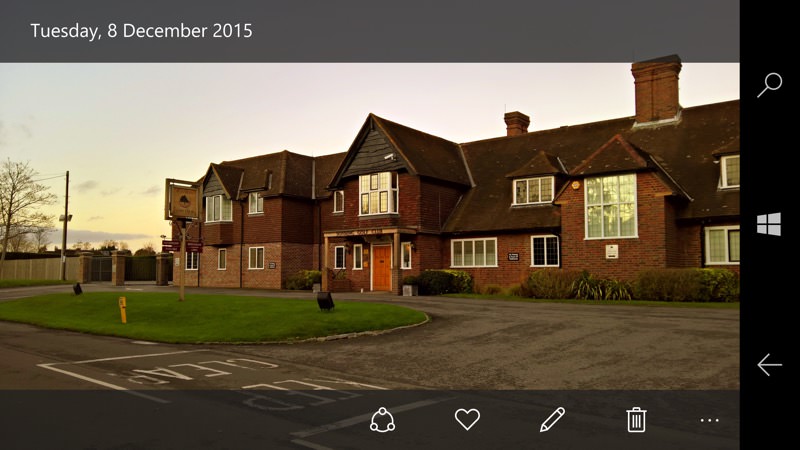
- When shooting people with flash, i.e. at an event or party, you may wish to pop back quickly, to see if people's eyes are closed (for example) - with Rich Capture in 'auto' mode, you will get a 'Dynamic Flash' photo set, meaning that you've got a full five seconds to wait before the snap is fully available to see in all its glory. However, in reality, the preview image is still usually good enough to spot a problem. But to alleviate even having to do this (and also to save disk space!), when at a badly lit family evening 'do', I found it appropriate to force LED flash on and turn Rich Capture off completely, ensuring that any 'finishing touches' delays lasted only a second or two.
Blinking issues!
One other thing worthy of note is that the triple LED flash is quite bright - obviously. In fact, it's bright enough to cause red eye in your subjects when they're looking straight at you. So, in order to alleviate this, Microsoft has programmed in a pre-flash a fraction of a second before the real thing, letting a subject's eyes react and close down their irises - in theory reducing 'red eye'. The only problem is that the pre-flash is also so bright that subjects tend to squint or blink as a result, so I ended up with quite a few shots of people with slits for eyes and not very attractive. I do wonder whether Microsoft should make the red-eye pre-flash an option? Or perhaps make the pre-flash only half as bright?
Zooming gets ugly
I mentioned the lossless PureView zoom above, assuming you're running the Lumia 950/XL camera in 8MP mode, but it's very important to note that there's no 'detent' or indicator as to when you hit 1:1 on the sensor when zooming. In other words, go past about 1.5x and you're into lossy 'made up'/interpolated detail territory. Going to 2x, 3x and then 4x gradually increases the degree of ugliness when you look at the resulting image - there's no real benefit in zooming at all beyond about 2x and I do wish Microsoft would put in some sort of indicator on-screen, perhaps showing green while lossless and then moving from this to orange and then red when heading into lossy/blocky territory. Or perhaps a simple textual indicator, such as '1x', '1.5x', '(2x)', '(3x)', i.e. putting lossy zoom settings in parentheses? Just a thought.
Mind you, in 16MP mode, the default in Windows 10 Camera, all zoom is lossy, since you're already at the sensor's limit. Will this be an issue for most people? Will it bother them as much as it bothers me?
And round the front...
Previous 900-series Lumias had paltry front facing cameras (by modern standards), but selfies are now officially a very big thing, of course, so it's not surprising to see Microsoft go with a 5MP front camera here on the Lumia 950.
Results are par for the course - nothing special, but fine for 'selfie' use in most light conditions - there's no front LED flash and there's no Rich Capture facility, which is a shame, but you can fiddle with the usual manual controls (ISO, exposure, etc.) if you really want to. But then that's against the spirit of selfies, so...
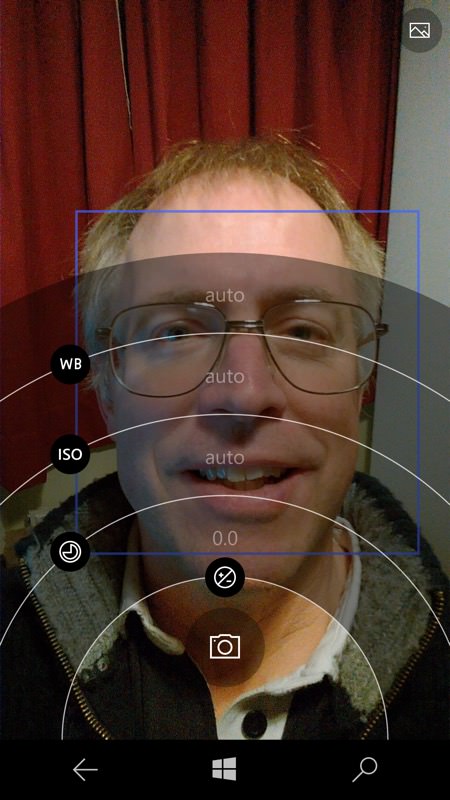

Unlike competing (Android) phone front cameras, there's no 'beauty' mode built-in, though 'Lumia Selfie' (above, right) is only ever a free install away, and this has more enhancement modes than you'll ever need.
Video capture
Video capture has been exemplary on Lumias for years now, with OIS being introduced with the Lumia 920 in 2012 and we reached the point with the Lumia 930 and 1520 where fully stabilised 4K video capture was quite practical. Not that many people need 4K capture even at the end of 2015, but it's there as a possibility (though the default is still, sensibly, at 1080p in Windows 10 Camera).
In addition to the OIS in video mode, there's also now an additional stabilisation layer in software, something which I analysed here. Much to my surprise, the combination of the two systems worked brilliantly and I suggest that this all be left 'on'.
Now, shooting video is very subjective and an awful lot depends on lighting, stability in the hand, subject matter, and so on, so I'll leave a full compendium of video capture footage and quality for a future article, perhaps in a head to head jig with the Lumia 930, 1020 or perhaps an iPhone. Your suggestions welcome here.
The main thing people seem to want to know about video capture is whether the Lumia 950 (and XL) have the same HAAC microphones and Rich Recording as the previous generations of Lumias. Absolutely. There are the same four high performance microphones, enabling surround sound at rock gig audio levels, though there's no mention of Dolby Digital in the settings for Windows 10 Camera and you'll have to make do with (ye olde) stereo until Microsoft codes the Dolby stuff back in.
Motorhead weren't playing anywhere near me this week, but I shot a few seconds of a blues combo nearby - they weren't ear-splittingly loud, but you'll still get a brief sense of captured audio quality. As I say, more in a future dedicated video feature.
As usual with Lumia Camera/Windows 10 Camera in low light with flashing lights, it's best to set the focus yourself during capture - I didn't above, so you see some auto-focus hunting, though I did try out the PureView zoom while shooting and this works as well as can be expected, given the very low light levels - it really was quite hard to see!
The Lumia 950 and 950 XL camera - verdict
There's so much to talk about here - I concentrated just on rear camera stills and functions and even then only really scratched the surface - and I'm still up to getting on for 3000 words. So expect some more specialist tutorials and features as we head into 2016 with these new flagships.
Overall, I've been really impressed by the main, PureView camera here. It's true that all the post-processing does get in the way occasionally, and it's true that images usually veer slightly towards 'wow' and rarely towards 'natural', but these are minor quibbles. The acid test is which phone I'd take with me on a big family day out with image quality being paramount - and I think I'd go with the Lumia 950 every time (the 950 XL's camera is the same, of course, but when you're mobile then a little compactness and better grippability helps!)
The Lumia 1020 may be able to zoom further and freeze party dancing better, but shot for shot I think I'd take the Lumia 950 (see here for proof) - add in that activating the camera is near instantaneous and that shot to shot times are a fraction of a second, then add on top of that the various Rich Capture flexibilities and it's clear that choosing the Lumia 950 camera as the pick of the crop is a no brainer.
Thanks very much to Clove for the loan of the retail devices used in these features!

Reviewed by Steve Litchfield at
